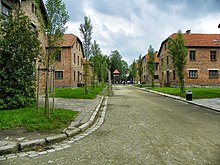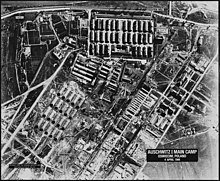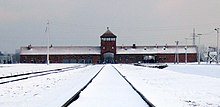Did the Polish build and run the camp?
Auschwitz I
Growth

Auschwitz I, 2013 (
50.027606°N 19.203088°E)

Auschwitz I, 2009; the prisoner reception center of Auschwitz I became the visitor reception center of the
Auschwitz-Birkenau State Museum.
[19]

Former prisoner reception center; the building on the far left with the row of chimneys was the camp kitchen.

Auschwitz I, 4 April 1944
A former World War I camp for transient workers, and later a Polish army barracks, Auschwitz I was the main camp (
Stammlager) and administrative headquarters of the camp complex. Situated 50 kms southwest of
Kraków, the site was first suggested in February 1940 as a quarantine camp for Polish prisoners by SS-
Oberführer Arpad Wigand, the inspector of the
Sicherheitspolizei (security police) and deputy of SS-
Obergruppenführer Erich von dem Bach-Zelewski, the
Higher SS and Police Leader for Silesia.
Richard Glücks, head of the
Concentration Camps Inspectorate, sent former
Sachsenhausen concentration camp commandant
Walter Eisfeld to inspect it.
[20] Around 1,000 m long and 400 m wide,
[21] Auschwitz consisted at the time of 22 brick buildings, eight of them two-story; a second story was added to the others in 1943 and eight new blocks were built.
[22]
Reichsführer-SS Heinrich Himmler, head of the
Schutzstaffel (SS), approved the site in April 1940 on the recommendation of SS-
ObersturmbannführerRudolf Höss of the camps inspectorate. Höss oversaw the development of the camp and served as its first commandant. The first 30 prisoners arrived on 20 May 1940 from the Sachsenhausen camp in
Oranienburg, Germany. German "career criminals" (
Berufsverbrecher), the men were known as "greens" (
Grünen) after the
green triangles they had to wear on their prison clothing. Brought to the camp as functionaries, this group did much to establish the sadism of early camp life, which was directed particularly at Polish inmates, until the political prisoners took over their roles.
[23] Bruno Brodniewitsch, the first prisoner (who was given serial number 1), became
Lagerältester (camp elder); the others were given positions such as
kapo and block supervisor.
[24]
Auschwitz II-Birkenau
Construction

Auschwitz II-Birkenau gate from inside the camp, 2007

The same scene, May/June 1944, with the gate in the background. "Selection" of
Hungarian Jews, chosen either for work or the
gas chamber. Photograph from the
Auschwitz Album.

Gate with the camp remains in the background, 2009
After visiting Auschwitz I in March 1941, it appears that Himmler ordered that the camp be expanded,
[37] although
Peter Hayes notes that, on 10 January 1941, the Polish underground told the
Polish government-in-exile in London: "the Auschwitz concentration camp ...can accommodate approximately 7,000 prisoners at present, and is to be rebuilt to hold approximately 30,000."
[38] Construction of Auschwitz II-Birkenau—called a
Kriegsgefangenenlager(prisoner-of-war camp) on blueprints—began in October 1941 in
Brzezinka, about three kilometers from Auschwitz I.
[39] The initial plan was that Auschwitz II would consist of four sectors (Bauabschnitte I–IV), each consisting of six subcamps (BIIa–BIIf) with their own gates and fences. The first two sectors were completed (sector BI was initially a quarantine camp), but the construction of BIII began in 1943 and stopped in April 1944, and the plan for BIV was abandoned.
[40]
SS-Sturmbannführer
Karl Bischoff, an architect, was the chief of construction.
[37] Based on an initial budget of RM 8.9 million, his plans called for each barracks to hold 550 prisoners, but he later changed this to 744 per barracks, which meant the camp could hold 125,000, rather than 97,000.
[41] There were 174 barracks, each measuring 35.4 by 11.0 metres (116 by 36 ft), divided into 62 bays of 4 square metres (43 sq ft). The bays were divided into "roosts", initially for three inmates and later for four. With personal space of 1 square metre (11 sq ft) to sleep and place whatever belongings they had, inmates were deprived,
Robert-Jan van Pelt wrote, "of the minimum space needed to exist".
[42]
The prisoners were forced to live in the barracks as they were building them; in addition to working, they faced long roll calls at night. As a result, most prisoners in BIb (the men's camp) in the early months died of
hypothermia, starvation or exhaustion within a few weeks.
[43] Some 10,000 Soviet prisoners of war arrived at Auschwitz I between 7 and 25 October 1941,
[44] but by 1 March 1942 only 945 were still registered; they were transferred to Auschwitz II,
[45] where most of them had died by May.
[46]
Auschwitz III-Monowitz
Main article:
Monowitz concentration camp

Detailed map of
Buna Werke,
Monowitz, and nearby subcamps
After examining several sites for a new plant to manufacture
Buna-N, a type of
synthetic rubber essential to the war effort, the German chemical cartel
IG Farben chose a site near the towns of
Dwory and Monowice (Monowitz in German), about 7 kilometres (4.3 mi) east of Auschwitz I.
[54] Tax exemptions were available to corporations prepared to develop industries in the frontier regions under the Eastern Fiscal Assistance Law, passed in December 1940. In addition to its proximity to the concentration camp, a source of cheap labor, the site had good railway connections and access to raw materials.
[55] In February 1941, Himmler ordered that the Jewish population of
Oświęcim be expelled to make way for skilled laborers; that all Poles able to work remain in the town and work on building the factory; and that Auschwitz prisoners be used in the construction work.
[56]
Auschwitz inmates began working at the plant, known as Buna Werke and IG-Auschwitz, in April 1941, and demolishing houses in Monowitz to make way for it.
[57] By May, because of a shortage of trucks, several hundred of them were rising at 3 am to walk there twice a day from Auschwitz I.
[58] Because a long line of exhausted inmates walking through the town of Oświęcim might harm German-Polish relations, the inmates were told to shave daily, make sure they were clean, and sing as they walked. From late July they were taken to the factory by train on freight wagons.
[59] Given the difficulty of moving them, including during the winter, IG Farben decided to build a camp at the plant. The first inmates moved there on 30 October 1942.
[60] Known as KL Auschwitz III-Aussenlager (Auschwitz III subcamp), and later as the Monowitz concentration camp,[61] it was the first concentration camp to be financed and built by private industry.
[62]
 Heinrich Himmler (second left)
Heinrich Himmler (second left) visits the
IG Farben plant in Auschwitz III, July 1942.
Measuring 270 by 490 metres (890 ft × 1,610 ft), the camp was larger than Auschwitz I. By the end of 1944, it housed 60 barracks measuring 17.5 by 8 metres (57 ft × 26 ft), each with a day room and a sleeping room containing 56 three-tiered wooden bunks.
[63] IG Farben paid the SS three or four
Reichsmark for nine- to eleven-hour shifts from each worker.
[64] In 1943–1944, about 35,000 inmates worked at the plant; 23,000 (32 a day on average) died as a result of malnutrition, disease, and the workload. Within three to four months at the camp,
Peter Hayes writes, the inmates were "reduced to walking skeletons".
[65] Deaths and transfers to the gas chambers at Auschwitz II reduced the population by nearly a fifth each month.
[66] Site managers constantly threatened inmates with the gas chambers, and the smell from the crematoria at Auschwitz I and II hung heavy over the camp.
[67]
Although the factory had been expected to begin production in 1943, shortages of labor and raw materials meant start-up was postponed repeatedly.
[68] The Allies bombed the plant in 1944 on 20 August, 13 September, 18 December, and 26 December. On 19 January 1945, the SS ordered that the site be evacuated, sending 9,000 inmates, most of them Jews, on a death march to another Auschwitz subcamp at
Gliwice.
[69] From Gliwice, prisoners were taken by rail in open freight wagons to the
Buchenwald and
Mauthausen concentration camps. The 800 inmates who had been left behind in the Monowitz hospital were liberated along with the rest of the camp on 27 January 1945 by the
1st Ukrainian Front of the
Red Army.
[70]
According to
Aleksander Lasik, about 6,335 people (6,161 of them men) worked for the SS at Auschwitz over the course of the camp's existence;
[85] 4.2 percent were officers, 26.1 percent non-commissioned officers, and 69.7 percent rank and file.
[86] In March 1941, there were 700 SS guards; in June 1942, 2000; and in August 1944, 3,342. At its peak in January 1945, 4,480 SS men and 71 SS women worked in Auschwitz; the higher number is probably attributable to the logistics of evacuating the camp.
[87] Female guards were known as SS supervisors (
SS-Aufseherinnen).
[88]
Most of the staff were from Germany or Austria, but as the war progressed, increasing numbers of
Volksdeutsche from other countries, including Czechoslovakia, Poland, Yugoslavia, and the Baltic states, joined the SS at Auschwitz. Not all were ethnically German. Guards were also recruited from Hungary, Romania, and Slovakia.
[89] Camp guards, around three quarters of the SS personnel, were members of the
SS-Totenkopfverbände (
death's headunits).
[90] Other SS staff worked in the medical or political departments, or in the economic administration, which was responsible for clothing and other supplies, including the property of dead prisoners.
[91] The SS viewed Auschwitz as a comfortable posting; being there meant they had avoided the front and had access to the victims' property.
[92]
https://en.wikipedia.org/wiki/Auschwitz_concentration_camp











